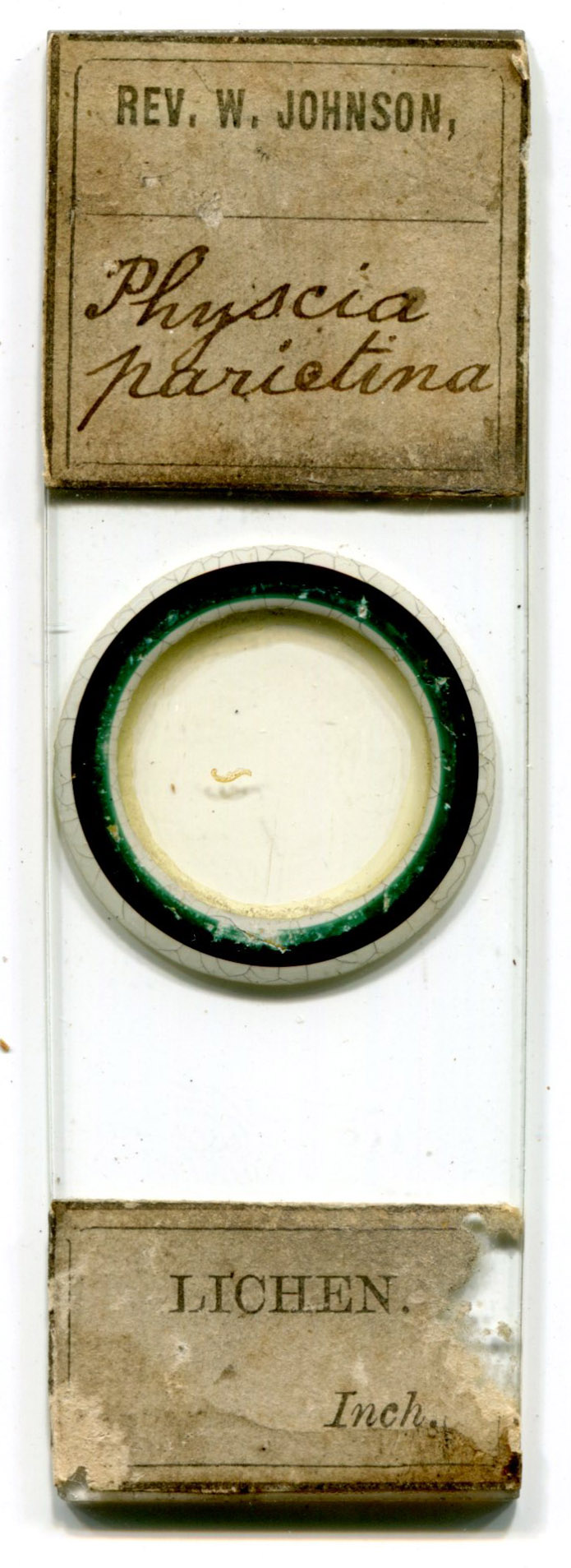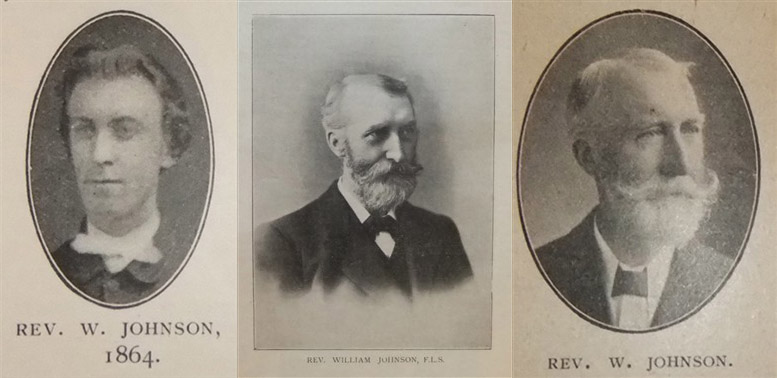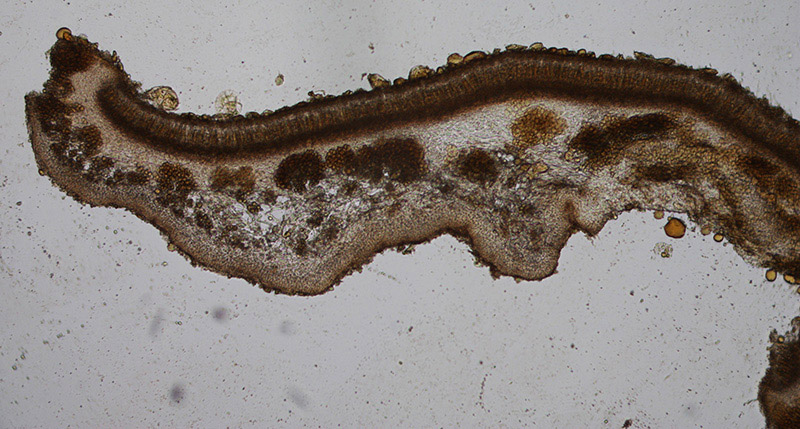
Figure 1. An example of a microscope slide by the Reverend William Johnson. This was probably made circa 1889, when Johnson was offering slides of lichens for 12 shillings per dozen (see Figure 2).
Reverend William Johnson, 1844 - 1919
by Brian Stevenson
last updated August, 2016
William Johnson was an amateur biologist, largely self-taught, who became a noted authority on British lichens. As have so many other successful scientists, Johnson found a quiet niche and explored it in great depth. A commentary on his 1889 The Lichens of Cumberland stated, “This paper indicates to the botanical student how he may do really original work in a field that is far from having been exhausted”.
Johnson appears to have begun serious study of lichens in the mid-1870s. By 1879, he was offering mounted microscope slides for exchange (Figure 2). Within ten years, he was commercially producing lichen slides, a likely example of which is shown in Figure 1. Between 1894 and 1918, he produced 13 different annotated sets of mounted lichens as The North of England Lichen-Herbarium.
He was a minister of the Primitive Methodist Church, described as “a rare blend of poet and scientist; painstaking in his research, and well known throughout the Primitive Methodist Church as a man of keen intellect; exceptionally gifted as a preacher, though his appeal was rather to the scholar than the man in the street”. An idea of his preaching style may be gathered from his scientific writings, which could quickly shift from the lofty to the serious, “Lichens are purely children of the country. They shun the grimy vicinities of our cities and towns. If found growing here, they are dwarfed and poor, life with them seems merely a struggle for existence, and in such conditions they seldom attain anything beyond a pulverulent state, or a discoloured, barren crust. They love the maiden country and the moist but stainless air. Aerial plants, they are of the earth, but not earthy. They cling to the very ground, yet are fed from heaven. Just what the water, with its solutions, is to the forests of floating algae in the sea and ponds, so the atmosphere, with its vapour and the chemical elements dissolved by it, is to the lichen. Like the Algae, lichens nourish themselves by cellular absorption, not in any particular parts like root-pores, but all over the surface; the margin or younger portion of the thallus being the most vigorous in growth. Consequently one part of the lichen does not depend upon another, like the branch and leaf of a flower-stalk, upon the stem. Not unfrequently, we have seen some foliaceous species like Physcia parietina, as well as crustaceous forms, growing on, in the margin or outer portion, when the centre or oldest part had been torn away. A fresh centre of development will even sometimes be seen filling up the vacant space”.

Figure 1.
An example of a microscope slide by the Reverend William Johnson. This was probably made circa 1889, when Johnson was offering slides of lichens for 12 shillings per dozen (see Figure 2).

Figure 2.
Advertisements for microscope slides prepared by William Johnson. In 1879, he offered slides of lichens in exchange for books. Other writings indicate that Johnson began to seriously study lichens in the mid-1870s, so these slides were probably amateurish. In 1889, Johnson offered a booklet on the Lichens of Cumberland, and prepared slides for 12 shillings a dozen. Beginning in 1894, he offered collections of lichen slides, issued in 13 sets through 1918.
William Johnson was born in Halifax, Yorkshire, on February 11, 1844, eldest of at least five children. The 1851 census recorded that his father, George, worked as a wool comber. William’s mother, Hannah, had been married previously, and her four children from that marriage lived with the family in 1851. William was then 7 years old, and was not yet working, although his 11 year-old half-brother was already working in the mills as a wool comber. Father George died during the 1850s. The 1861 census reported that Hannah and all of the children down through 10 years old were working in a wool mill.
William Johnson escaped mill life in 1864, when he was ordained as a minister of the Primitive Methodist Church. That undoubtedly led to an easier life, with time to spend on hobbies such as lichenology. W.H. Burrell commented that Johnson’s “specimens were gathered as he tramped the roads and moors on preaching appointments or on holidays”.
William married Elizabeth Clegg on July 7th, 1868, at Whitby, Yorkshire. Almost immediately upon arriving at their new home in Staithes, Yorkshire, Elizabeth came down with typhoid fever, then died of tuberculosis on the 9th of December.
A year later, William married Marianne Sawyer. They had two children, Thomas (born 1870) and George (born 1874) Materially, life improved substantially for William. The 1871 census, and those for many years afterward, reported that he employed live-in servants.
As mentioned above, Johnson probably began serious studies of lichens in the mid-1870s. Leighton’s 1879, third edition of Lichen-flora of Great Britain, Ireland, and the Channel Islands lists dozens of species that were identified by Johnson. The second edition, published in 1872, did not mention Johnson. A later paper by Johnson on “New British lichens” reported gathering a lichen “on the rocks by the side of the River Tyne, at Bywell, Northumberland, in 1878”. Johnson was offering to exchange microscope slides of lichens in 1879. He was, however, still looking to acquire basic books on lichen biology (Figure 2).
In 1879, Johnson published a significant contribution toward understanding the negative effects of manmade pollution on the environment. His paper continues to be cited for its insightfulness. “During the spring of the present year, I was very much struck with the disastrous effects of a deleterious atmosphere on the growth of lichens. At the same time, I felt very forcibly the confirmation of the fact that these humble plants, so beautifully covering nature's less graceful parts, as well as pioneering a higher vegetable growth, are themselves aerial plants. What the water with its solutions is to the Algae, so the air with its chemical substances is to the lichen. If the latter fed and nourished its growth through its rhizinre or from the matrix, we should be at a loss to understand the utter obliteration of plants in the same circumstances which once flourished in fruited luxuriance. Growing with other plants in the same place, if it nourished itself in the same way, we should naturally expect the lichen to hold its own with its fellows, subject, of course, to those changes which come alike to all vegetable life ; but it is not so. The lichen will entirely disappear from a spot without any observable change in the other vegetation around, and that from a pollution of the air which is not sufficient to affect those plants which nourish themselves from the soil or matrix of growth. In Winch's ‘Flora of Northumberland’, published in the Trans. Nat. Hist. Society of Northumberland and Durham, 1832, mention is made of a number of lichens growing in the woods at Gibside, Durham. Amongst the plants enumerated is Evernia prunastri (L), said to be in fructification in Gibside Woods. As I have never had the pleasure of gathering this species in fruit in any part of North Durham, or the west and south of Northumberland (which I have more or less searched), I went out to Gibside in the spring to see if I could find the above lichen. Gibside is some seven miles from Newcastle to the southwest. The hall is beautifully placed on the Derwent. The surrounding woods run back on to Whickham Fell. On the latter I found one or two forms of Callema, and what seemed to be Peltigera malacea, but it was not in fruit, and a few of the commoner forms of Lecanora and Lecidea. Gibside Woods, barring the atmosphere, are favourable enough for the growth of fructiculose and foliaceous lichens, but for any of these forms I searched them in vain. Not a trace of the series Ramalodei could I find. The trees were as barren of Usnea, Ramalina, and Evernia as if they had never known them, and I might say of almost every other form. I found here and there on an old fir a few barren patches of the thallus of some Calicium, and I noticed a few forms of Lecanora and Lecidea by the river side. The lichens which flourished here in the fine condition spoken of by Winch have perished, and this evidently from the pollution of the atmosphere by the smoke and fumes from the Tyneside, and the collieries of the surrounding district. Though these are a considerable distance from Gibside, yet the deleterious elements travel on the wind, for the trees have that dusky coating on their trunks and branches which is peculiar to trees bordering a town, and which is fatal to lichen-growth. W. Johnson. Gateshead-on-Tyne”.
William Johnson was elected to membership in the Linnean Society on April 19, 1888. He remained a member through 1913.
Johnson issued the first volume of his North of England Lichen Herbarium in 1894. This consisted primarily of specimens collected by Johnson in Cumberland, Durham and Northumberland. Thirteen issues were produced over the next 24 years. While many of the specimens to produce slides for this series were freshly collected, Johnson also cut into his personal collection. A 1972 report on Johnson’s herbarium that had been donated to Leeds University “revealed that much of the material had been removed prior to its acquisition (the labels remaining) no doubt for the purpose of providing specimens for his thirteen North of England Lichen-Herbarium fascicles which appeared in 1894 (1-2), 1895(3-5), 1896(6), 1897 (7), 1898 (8), 1900 (9), 1906 (10), 1910 (11), 1914 (12) and 1918 (13)”.
Johnson served as Principal of Hartley Theological College, Manchester, from 1903 until 1908. Also in 1903, his wife Marianne died. Around about 1906, William married a third time, to Mary (last name not known).
His health failing, William was superannuated to Hull, Yorkshire, in 1908. He retired in 1910, settling in Harrogate, Yorkshire. Johnson died at his home on August 29, 1919.

Figure 3.
Photographs of William Johnson. Left to right: 1864, 1900, 1919. From http://www.myprimitivemethodists.org.uk/page_id__1924_path__0p3p45p56p147p.aspx.

Figure 4.
Magnified detail of Physica parietina, prepared by William Johnson (see Figure 1).
Resources
Ainsworth, Geoffrey C. (1996) Brief Biographies of British Mycologists, Edited by John Webster and David Moore, British Mycological Society, Stourbridge, West Midlands, page 97
Blackwell, E.M. (1961) Links with past Yorkshire naturalists, The Naturalist, April-June issue, pages 53-66
Burrell, W.H. (1929). William Johnson: A Yorkshire Botanist, The Naturalist, August issue, pages 285-286
Dickinson, Geoff (accessed August, 2016) William Johnson, F.L.S., http://www.myprimitivemethodists.org.uk/page_id__1924_path__0p3p45p56p147p.aspx
England census, birth, marriage, and death records, accessed through ancestry.com
Grevillea (1894) Announcement of William Johnson’s issue of North of England Lichen Herbarium, Vol. 22, page 114
Hardwicke’s Science-Gossip (1879) Exchange offer from William Johnson, Vol. 15, page 24
Johnson, W. (1879) Lichens and a polluted atmosphere, Hardwicke’s Science-Gossip, Vol. 15, page 217
Johnson, W. (1881) New British lichens, Journal of Botany, Vol. 19, pages 113-114
Johnson, W. (1881) An Introduction to the Study of Lichens, American Monthly Microscopical Journal, Vol. 2, pages 169-171, 181-183, and 201-206
Johnson, W. (1881) A New lichen found in Northumberland, Natural History Transactions of Northumberland, Durham, and Newcastle-on-Tyne, Vol. 8, page 184
Johnson, W. (1884) Lichen memorabilia, Natural History Transactions of Northumberland, Durham, and Newcastle-on-Tyne, Vol. 8, pages 217-218
Johnson, W. (1887) A Catalogue of Mr. N. J. Winch’s lichens, now in the Museum of the Natural History Society, Newcastle-upon-Tyne, Natural History Transactions of Northumberland, Durham, and Newcastle-on-Tyne, Vol. 8, pages 307-325
Johnson, W. (1889) Lichenology, The Wesley Naturalist, Vol. 1, pages 174-176
The Journal of the Linnean Society (1888) “April 19th, 1888 … Frederick Ernest Weiss, Esq., Rev. William Johnson, and Dr. Reginald Gervase Alexander were elected Fellows”, Vol. 22, page 11
Leighton, William Allport (1879) The Lichen-flora of Great Britain, Ireland, and the Channel Islands, Third edition, Leighton, Shrewsbury. Contains numerous references to lichens collected by Reverend Johnson. The second edition, published in 1872, does not mention Johnson
Probate of William Johnson (1919) “Johnson the reverend William of Brookfield Rossett Drive Harrogate clerk died 20 July 1919 Probate London 29 August to Thomas Sawyer Johnson accountant and George Vicars Johnson engineer. Effects £2116 18s 8d”, accessed through ancestry.com
Seaward, M.R.D. (1972) William Johnson’s lichen collection, The Naturalist, January-March issue, pages 13-14
The Wesley Naturalist (1889) Review of Johnson’s The Lichens of Cumberland, Vol. 1, page 127
The Wesley Naturalist (1889) Advertisement from William Johnson for his prepared microscope slides of lichens, and his book The Lichens of Cumberland, Vol. 1, page 128
Who’s Who (1907) “Johnson, William. F.L.S.; Principal, Hartley Theological College, Manchester; h. Halifax, West Yorkshire, 1844; married. Educ.: private tuition. Entered Primitive Methodist Ministry, 1864; Building Committee Secretary, Sunderland District, six years. Publications: Introduction to the Study of Lichens in Northern Microscopist, 1881; A Catalogue of Mr. N. J. Winch's Lichens in the Museum, Newcastle-on-Tyne, 1887; North of England Lichen Herbarium, 1894; Nature and Naturalists, 1903. Recreations: trout fishing and botanising. Address: Hartley College, Alexandra Road South, Manchester”, page 944, Adam & Charles Black, London